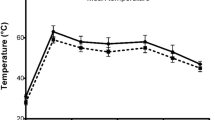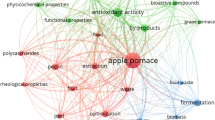Abstract
Capsaicin, an active component of hot pepper, has considerable health benefits; however, the pungency of hot pepper has limited its usage. This study aimed to reduce the pungency of hot pepper by fermentation to enhance its application in the food industry. Hot pepper juice was fermented by Bacillus licheniformis SK1230, which was previously isolated as a capsaicin-degrading bacterium. B. licheniformis SK1230 was inoculated into the juice of red or green pepper, and the mixture was then fermented for 19 days to determine the degradation level of capsaicinoids. It was observed that with a gradual increase in pH, the growth of B. licheniformis SK1230 increased to 1.0 × 109 CFU/mL after day 1, and its viability persisted until the end of fermentation. The sugar content of green pepper drastically reduced at day 1 and that of red pepper reduced at day 5. The total polyphenol content of the medium containing red pepper was about 2-fold higher than that of the medium containing green pepper. The antioxidant activity of the medium containing red pepper was also higher than that of the medium containing green pepper; however, the activity gradually decreased during the course of the fermentation period. The capsaicinoid content of both types of peppers radically decreased at day 5. Thus, we suggest that a fermentation period of 5 days would be optimal for the degradation of capsaicin with minimal loss of antioxidant activity and would provide higher polyphenol content.



Similar content being viewed by others
References
Brans A, Filee P, Chevigne A, Claessens A, Joris B (2004) New integrative method to generate subtilis recombinant strains free of selection markers. Appl Environ Microbiol 70:7241–7250
Castro SM, Saraiva JA, Lopes-da-Silva JA, Delgadillo I, Loey AV, Smout C (2008) Effect of thermal blanching and of high pressure treatments on sweet green and red bell pepper fruit (Capsaium annum L.). Food Chem 107:1436–1449
Cho BC, Park KW, Kang HM, Lee WM, Choe JS (2004) Correlationship between climatic elements and internal characteristics of red pepper fruit in different growing periods. J Bio-Environ Control 13:67–72
Cho S, Moon HI, Hong GE, Lee CH, Kim JM, Kim SK (2014) Biodegradation of capsaicin by Bacillus licheniformis SK1230. J Korean Soc Appl Biol Chem 57:335–339
Choi SM, Jeon YS, Park KY (2000) Comparison of quality of red pepper powders produced in Korea. Korean J Food Sci Technol 32:1251–1257
Conforti F, Giancarlo AS, Francesco M (2007) Chemical and biological variability of hot pepper fruits (Capsicum annuum var. acuminatum L.) in relation to maturity stage. Food Chem 102:1096–1104
Gonzalez-Aguilar G, Robles-Sanchez RM, Martinez-Tellez MA, Olivas GI, Alvarez-Parrilla E, De La Rosa LA (2008) Bioactive compounds in fruits: health benefits and effect of storage conditions. Stewart Postharvest Rev 4:1–10
Hill TA, Ashrafi H, Reyes S, Truco M, Kozik A, Michelmore RW, Van Denze A (2013) Characterization of Capsaicin annuum genetic diversity and population structure based on parallel polymorphism discovery with a 30 K unigene pepper genechip. PLoS One 8:e56200
Hsu CL, Yen GC (2007) Effects of capsaicin on induction of apoptosis and inhibition of adipogenesis in 3T3-L1 cells. J Agric Food Chem 55:1730–1736
Hwang SY, Ahn YH, Shin GM (2001) A study on the quality of commercial red pepper powder. Korean J Food Nutr 14:424–428
Hwang IG, Kim HY, Lee JS, Kim HR, Cho MC, Ko IB, Yoo SM (2011) Quality characteristics of Cheongyang pepper (Capsicum annuum L.) according to cultivation region. J Korean Soc Food Sci Nutr 40:1340–1346
Hwang IG, Jeong HS, Lee JS, Kim HY, Yoo SM (2012) Influence of freezing and thawing temperature on the quality characteristics of mashed red pepper. Korean J Food Nutr 25:691–696
Juan MY, Chou CC (2010) Enhancement of antioxidant activity, total phenolic and flavonoid content of black soybeans by solid state fermentation with Bacillus subtilis BCRC 1471. Food Microbiol 27:586–591
Lee SM, Lee HS, Lee J, Yu KW, Suh HJ (2010) Non-pungent capsicum fermentation by B. subtilis P3-3 and its swimming endurance capacity in mice. Enzyme Microb Technol 47:200–205
Materska M, Perucka I (2005) Antioxidant activity of the main phenolic compounds isolated from hot pepper fruits (Capsicum annuum L.). J Agric Food Chem 53:1750–1756
Meghvansi MK, Siddiqui S, Khan MH (2010) Naga chilli: a potential source of capsaicinoids with broad-spectrum ethnopharmacological applications. J Ethnopharmacol 132:1–14
Miller GL (1959) Use of dinitrosalicylic acid reagent for determination of reducing sugar. Anal Chem 31:426–428
Park JSCJ, Kim YK, Line LL, Chew BP (2010) Astaxanthin decreased oxidative stress and inflammation and enhanced immune response in humans. Nutr Metab (Lond) 7:18–23
Scalbert A, Manach C, Morand C, Remesy C, Jimenez L (2005) Dietary polyphenols and the prevention of disease. Crit Rev Food Sci Nutr 45:933–956
Shintaku K, Uchida K, Suzuki Y, Zhou Y, Fushik T, Watanabe T, Yazawa S, Tominaga M (2012) Activation of transient receptor potential A1 by a non-pungent capsaicin-like compound, capsiate. Br J Pharmacol 165:1476–1486
Surh YJ (2002) Anti-tumor promoting potential of selected spice ingredients with antioxidative and anti-inflammatory activities; a short review. Food Chem Toxicol 202:1091–1097
van den Heuvel RHH, Fraaije MW, Laane C, van Berkel WJH (2001) Enzymatic synthesis of vanillin. J Agric Food Chem 49:2954–2958
Yeon SJ, Kim SK, Kim JM, Lee SK, Lee CH (2013) Effect of fermented pepper powder on body fat accumulation in mice fed a high-fat diet. Biosci Biotechnol Biochem 77(11):2294–2297
Zimmer AR, Leonardi B, Miron D, Schapoval E, Oliveira JR, Gosmann G (2012) Antioxidant and anti-inflammatory properties of Capsicum bacatum: from traditional use to scientific approach. J Ethnopharmacology 139:228–233
Acknowledgments
This research was supported by the Ministry for Food, Agriculture, Forestry and Fisheries, Republic of Korea.
Author information
Authors and Affiliations
Corresponding author
Additional information
Sangbuem Cho and Jeong-Mee Kim equally contributed to this study.
Rights and permissions
About this article
Cite this article
Cho, S., Kim, JM., Yu, MS. et al. Fermentation of hot pepper juice by Bacillus licheniformis to reduce pungency. J Korean Soc Appl Biol Chem 58, 611–616 (2015). https://doi.org/10.1007/s13765-015-0078-y
Received:
Accepted:
Published:
Issue Date:
DOI: https://doi.org/10.1007/s13765-015-0078-y




